How to Diagnose Peripheral Neuropathy: A Comprehensive Guide


Peripheral neuropathy is a condition that affects the peripheral nerves, causing symptoms such as numbness, tingling, weakness, and pain in the extremities. It can significantly impact a person’s quality of life, making early detection and diagnosis crucial. This article will explore the various methods used to test for peripheral neuropathy, helping individuals and healthcare professionals promptly identify the condition.
Clinical Evaluation
The first step in diagnosing peripheral neuropathy involves a comprehensive clinical evaluation. A healthcare provider will take a detailed medical history and inquire about the patient’s symptoms, family history, medical conditions, and any medications they are taking. This information helps the doctor understand the patient’s overall health and assess their risk factors for neuropathy.
Neurological Examination
A thorough neurological examination is essential in pinpointing signs of peripheral neuropathy. A healthcare professional will assess muscle strength, reflexes, coordination, and sensation in the affected areas during this assessment. Abnormal reflexes or muscle weakness may indicate nerve damage.
Nerve Conduction Studies
Nerve conduction studies (NCS) are valuable tests to diagnose peripheral neuropathy. These tests measure how quickly electrical signals travel along the nerves. Electrodes are placed on the skin, and small electrical shocks are applied to stimulate the nerves. The speed and strength of the nerve’s response are recorded, helping doctors determine the extent of nerve damage.
Electromyography
Electromyography (EMG) is often performed alongside nerve conduction studies. EMG assesses the electrical activity of muscles. A thin needle electrode is inserted into specific powers, and the electrical signals produced during muscle contraction and relaxation are recorded. EMG results can help differentiate between muscle and nerve disorders, aiding in diagnosing peripheral neuropathy.
Quantitative Sensory Testing
Quantitative sensory testing (QST) is a non-invasive method that assesses a person’s response to various sensory stimuli, such as temperature, pressure, and vibration. By comparing a patient’s sensory perception to established norms, healthcare professionals can identify abnormalities indicative of peripheral nerve damage.
Skin Biopsy
Skin biopsy is a relatively new diagnostic technique to assess tiny nerve fibers in the skin. A small piece of skin is removed and examined under a microscope. This test can detect damage to the tiny nerve fibers responsible for sensations like pain and temperature. Skin biopsy is particularly useful for diagnosing certain types of peripheral neuropathy, such as small fiber neuropathy.
Blood Tests
Blood tests play a crucial role in diagnosing underlying causes of peripheral neuropathy. Conditions like diabetes, vitamin deficiencies, and autoimmune disorders can damage nerves. Blood tests can identify elevated blood sugar levels, vitamin deficiencies (such as B12 and folate), and the presence of antibodies associated with autoimmune disorders.
Imaging Studies
In some cases, imaging studies like MRI (magnetic resonance imaging) and CT (computed tomography) scans may be ordered. These tests can help identify structural abnormalities, such as herniated discs or tumors, that might be compressing or damaging nerves. Imaging studies are instrumental when there is suspicion of nerve compression due to underlying anatomical issues.
Nerve Biopsy
Nerve biopsy is a more invasive procedure that involves removing a small sample of nerve tissue for examination. This is usually reserved for cases where other diagnostic methods have not provided a conclusive diagnosis. Nerve biopsies can help identify the specific type of nerve damage and guide treatment decisions.
Diagnosing peripheral neuropathy requires a multi-faceted approach, combining clinical evaluation, specialized tests, and medical history analysis. Early detection is essential for managing the condition effectively and preventing further nerve damage. If you or someone you know is experiencing symptoms such as numbness, tingling, weakness, or pain in the extremities, seeking medical attention promptly is crucial. A healthcare professional can determine the appropriate tests to diagnose peripheral neuropathy and develop a tailored treatment plan to improve the patient’s quality of life. Remember, a timely diagnosis can make all the difference in managing this challenging condition.
